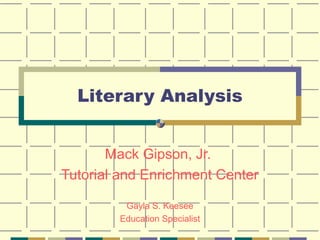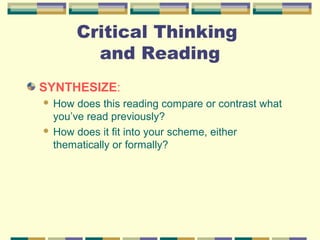Introlit analysis-1217252303491728-9
- 1. Literary Analysis Mack Gipson, Jr. Tutorial and Enrichment Center Gayla S. Keesee Education Specialist
- 2. Literature focuses on the search for reasons, values, and interpretations in all areas of human interest and experience. Because literature presents us with more than one possible meaning, interpreting literature requires more care and attention than does responding to an essay.
- 3. How to proceed Read slowly and carefully. Plan on reading the work several times. Ask questions to establish the literal meaning first; then work on interpretation. Annotate as you read. Identify themes and patterns.
- 4. An analysis explains what a work of literature means, and how it means it.
- 5. Critical Thinking and Reading Responding to literature with a critical temperament means always being willing to analyze, interpret, question, synthesize, and evaluate.
- 6. Critical Thinking and Reading ANALYZE ’ü¼ What does the passage mean, literally? INTERPRET: ’ü¼ What does it mean figuratively? ’ü¼ Are there symbolic overtones? ’ü¼ Can it mean more than one thing? ’ü¼ What passages in the text lead you to believe this is a valid interpretation?
- 7. Critical Thinking and Reading QUESTION: ’ü¼ What problems are suggested by the reading? ’ü¼ What's confusing? ’ü¼ If you had the author here, what would you ask? ’ü¼ What philosophical question(s) does the reading inspire?
- 8. Critical Thinking and Reading SYNTHESIZE: ’ü¼ How does this reading compare or contrast what youŌĆÖve read previously? ’ü¼ How does it fit into your scheme, either thematically or formally?
- 9. Critical Thinking and Reading EVALUATE: ’ü¼ Is it a first rate piece of writing or fifth rate piece of writing? ’ü¼ What criteria do you use to establish this judgment? ’ü¼ If you are evaluating a poem, for instance, what defines a first rate poem? ’ü¼ How does this particular poem match up to that standard? ’ü¼ Can you point to the exact places in the text to support your reading?
- 10. What is Literary Analysis? ItŌĆÖs literary ItŌĆÖs an analysis ItŌĆÖsŌĆö An Argument! Uses evidence from the text May also involve research on and analysis of secondary sources
- 11. How is it ŌĆ£literaryŌĆØ? Usually, a literary analysis will involve a discussion of a text as writing, thus the term literary, which means ŌĆ£having to do with lettersŌĆØ This will involve the use of certain concepts that are very specifically associated with literature
- 12. How to Analyze a Story ŌĆó Essential Elements of the Story ŌĆó Structure of the Story ŌĆó Rhetorical Elements ŌĆó Meaning of the Story
- 13. How to Analyze a Story Essential Elements of the Story ’ü¼ Plot: Relationship and patterns of events ’ü¼ Characters: people the author creates ’ü¼ Including the narrator of a story or the speaker of a poem ’ü¼ Setting: when and where the action happens ’ü¼ Point of View: perspective or attitude of the narrator or speaker ’ü¼ Theme: main ideaŌĆöwhat the work adds up to
- 14. Plot Exposition: Introductory material giving setting, tone, characters Rising Action: series of complications leading up to the climax Conflict: Person vsŌĆ”Person, Nature, Society, Supernatural, Self Crisis/Climax: Turning point in the conflictŌĆö moment of highest interest and/or emotion Falling Action: Events after the climax which close the story. Resolution (Denouement): Concludes the action
- 15. Plot Sequence Crisis/Climax Rising Falling Action Action Complications leading to Conflict(s) Resolution Introduction
- 16. Characterization Round Protagonist Three-dimensional personality Main character Flat Antagonist Only one or two striking Character or force qualitiesŌĆöall bad or all good that opposes the main character Dynamic Grows and progress to a Foil higher level of understanding Character that provides a contrast to Static the protagonist Remain unchanged throughout the story
- 17. Point of View First Person ’ü¼ Narrator is a character within the storyŌĆöreveals own thoughts and feelings but not those of others Third Person ’ü¼ Objective: narrator outside the story acts as a reporter ŌĆöcannot tell what characters are thinking ’ü¼ Limited: narrator outside the story but can see into the mind of one of the characters ’ü¼ Omniscient: narrator is all-knowing outsider who can enter the mind of more than one character.
- 18. Setting Time period Instrumental in Geographical location establishing mood Historical and cultural May symbolizes the context emotional state of ’ü¼ Social characters ’ü¼ Political Impact on ’ü¼ Spiritual charactersŌĆÖ motivations and options
- 19. Theme Main idea or underlying meaning of the literary work. ’ü¼ What the author wants the reader to understand about the subject ’ü¼ In fables, this may also be the moral of the story
- 20. Common Themes in Literature Questions, issues or Conflicts: problems: what is freedom vs. restraint, right or wrong; good poverty vs. wealth or bad; worthwhile or unimportant Common topics: self-realization, Abstract ideas: love, mortality, fall from death, honor innocence, search for the meaning of life.
- 21. How to Analyze a Story Structure of the Story: design or form of the completed action ’ü¼ May philosophically mirror the authorŌĆÖs intentions ’ü¼ How the author uses the elements of the story to reveal his/her theme ’ü¼ Look for repeated elements in action, gestures, dialogue, description as well as shifts in direction, focus, time, place, etc.
- 22. How to Analyze a Story Rhetorical Elements: Identify the authorŌĆÖs use and explain their importance ’ü¼ Foreshadowing ’ü¼ Use of hints or clues to suggest event that will occur later in the story ’ü¼ Builds suspenseŌĆömeans of making the narrative more believable ’ü¼ Tone ’ü¼ AuthorŌĆÖs attitudeŌĆöstated or impliedŌĆötoward the subject ’ü¼ Revealed through word choice and details
- 23. Rhetorical Elements Mood ’ü¼ Climate of feeling in a literary work ’ü¼ Choice of setting, objects, details, images, words Symbolism ’ü¼ Person, place, object which stand for larger and more abstract ideas ’ü¼ American flag = freedom ’ü¼ Dove = peace
- 24. Rhetorical Elements Irony: contrast between what is expected or what appears to be and what actually is ’ü¼ Verbal IronyŌĆöcontrast between what is said and what is actually meant ’ü¼ Irony of SituationŌĆöan event that is the opposite of what is expected or intended ’ü¼ Dramatic IronyŌĆöAudience or reader knows more than the characters know
- 25. Rhetorical Elements Figurative Language: language that goes beyond the literal meaning of words ’ü¼Simile ’ü¼Metaphor ’ü¼Personification ’ü¼Oxymoron ’ü¼Hyperbole
- 26. How to Analyze a Story Meaning of the Story (Interpretation) ’ü¼ Identify the theme(s) and how the author announces it. ’ü¼ Explain how the story elements contribute to the theme. ’ü¼ Identify contextual elements (allusions, symbols, other devices) that point beyond the story to the authorŌĆÖs life/experience, history or to other writings.
- 27. How do I support a thesis statement? Examples from the text ’ü¼ Direct quotations ’ü¼ Summaries of scenes/action ’ü¼ Paraphrases Other criticsŌĆÖ opinions Historical and social context
- 28. Supporting Your Thesis The Text (Primary Source) ’ü¼ As you write, consistently refer to the text to support your purpose. ’ü¼ Use the authorŌĆÖs own wordsŌĆöquotes. ’ü¼ No right or wrong interpretation as long as you can support it from the text. Secondary Sources ’ü¼ Literary Criticism




























